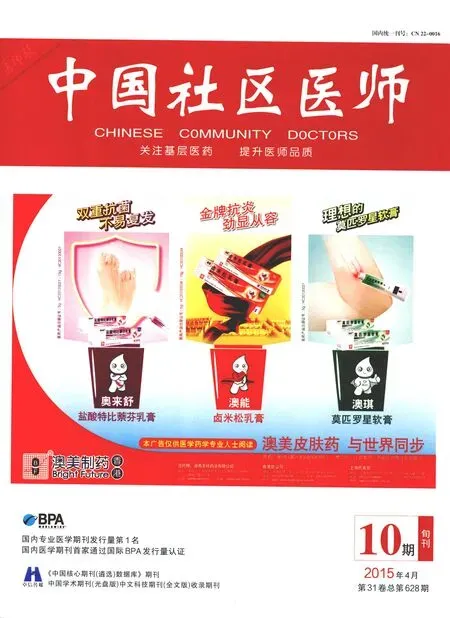氧疗对稳定期COPD患者肺功能及动脉血气的影响
王淑梅 徐喜媛014010内蒙古医科大学第三附属医院(包钢医院)
氧疗对稳定期COPD患者肺功能及动脉血气的影响
王淑梅 徐喜媛
014010内蒙古医科大学第三附属医院(包钢医院)
目的:总结氧疗对稳定期慢性阻塞性肺疾病(COPD)患者肺功能及动脉血气的影响情况。方法:2013年4月-2014年11月收治稳定期COPD患者70例,随机分成观察组和对照组各35例,对照组给予常规治疗方法,观察组在对照组的基础上增加氧疗,氧气流量控制在2 L/m in,连续氧疗10 h,每天坚持氧疗1次。结果:两组患者治疗前MMEF和FEV1比较差异无统计学意义(P>0.05);治疗后两组均明显改善,与治疗前比较差异有统计学意义(P<0.05);观察组明显优于对照组,两组治疗后比较差异有统计学意义(P<0.05);两组患者治疗前PaO2和PaCO2比较差异无统计学意义(P>0.05);治疗后,观察组明显优于对照组,两组比较差异有统计学意义(P<0.05)。观察组临床控制12例,显效21例,有效1例,无效1例,总有效率97.1%;对照组临床控制4例,显效14例,有效10例,无效7例,总有效率80.0%,两组比较差异有统计学意义(P<0.05)。结论:稳定期COPD患者增加氧疗可以明显改善患者动脉血气,提高血氧饱和度,临床疗效显著,值得推广。
稳定期;COPD;动脉血气;血氧饱和度
资料与方法
2013年4月-2014年11月收治稳定期COPD患者70例,随机分成观察组和对照组各35例,其中观察组男20例,女15例,年龄52~82岁,平均69.9岁;对照组男21例,女14例,年龄52~88岁,平均71.5岁。两组患者一般资料比较差异无统计学意义(P>0.05),有可比性。
方法:对照组给予常规治疗方法,即给予支气管扩张剂、祛痰药及营养支持。观察组在对照组的基础上增加氧疗,氧气流量控制在2 L/min,连续氧疗10 h,每天坚持氧疗1次。
统计学方法:所有数据采用SPSS 16.0进行统计分析,计量资料用±s)表示,采用t检验;计数资料采用χ2检验;P<0.05为差异具有统计学意义。
结果
两组患者治疗前后肺功能变化:两组患者治疗前MMEF和FEV1比较差异无统计学意义(P>0.05),治疗后两组均明显改善,与治疗前比较差异有统计学意义(P<0.05),观察组明显优于对照组,两组治疗后比较差异有统计学意义(P<0.05),见表1。
两组患者治疗前后动脉血气变化:两组患者治疗前PaO2和PaCO2比较差异无统计学意义(P>0.05),治疗后,观察组明显优于对照组,两组比较差异有统计学意义(P<0.05),见表2。
两组患者临床疗效比较:观察组临床控制12例,显效21例,有效1例,无效1例,总有效率97.1%;对照组临床控制4例,显效14例,有效10例,无效7例,总有效率80.0%,两组比较差异有统计学意义(P<0.05),见表3。
讨论
COPD发病的主要病理机制目前依然尚未完全清晰。但是从过往的研究中可以看出,该疾病的发生与多种诱发性的因素密切相关。例如空气污染、吸入性的颗粒性污染物等,都会对患者的肺部支气管远端肺泡造成刺激和损伤,从而导致诸如肺部的肺泡、呼吸性细支气管等组织出现硬化而失去弹性,功能性丧失等情况[1],此过程中往往伴随着气道的损坏,患者由于呼吸不畅所引起的一系列并发症,例如营养不良、免疫力低下、呼吸衰竭等不良症状[2]。从动脉血气上分析,患者的PaO2下降,PaCO2上升,动脉中的氧饱和度远不足于维持组织的需要,患者出现缺氧状态,严重时还会造成生命危险。
Influenceof oxygen therapy on the pulmonary function and arterialblood gasof COPD patients in stable stage
Wang Shumei,Xu Xiyuan
The Third Affiliated Hospitalof InnerMongoliaMedicalUniversity(Baogang Hospital)014010
Objective:To summarize the influence of oxygen therapy on the pulmonary function and arterial blood gas of COPD patients in stable stage.Methods:70 COPD patients in stable stage were selected from April 2013 to November 2014.They were random ly divided into the observation group and the control group with 35 cases in each.The control group was given routine treatmentmethod,and the observation group was given oxygen therapy on the basis of the control group.The oxygen flow was controled in 2 L/minutes,the continuous oxygen therapy 10 hours,insiston oxygen cure 1 time one day.Results:MMEF and FEV1 before treatment of patients in two groups were compared with no statistical significance(P>0.05);the two groups were significantly improved after treatment,itwas compared with before treatmentwith statistical significance(P<0.05);the observation group was significantly better than the controlgroup,the two groupsafter treatmentwere compared with statistically significant(P<0.05).PaO2and PaCO2before treatment of patients in two groups were compared with no statistical significance(P>0.05);after treatment,the observation group was significantly better than the control group,the two groups were compared with statistically significant(P<0.05).In the observation group,12 caseswere clinical control,21 cases were excellent,1 case was effective,1 case was invalid,the total effective rate was 97.1%.In the control group,4 caseswere clinical control,14 caseswere excellent,10 case was effective,7 casewas invalid,the totaleffective ratewas 80.0%.The two groupswere compared with statisticalsignificance(P<0.05).Conclusion:COPD patients in stable stage increased oxygen therapy can significantly improve the arterial blood gas of patients,improveblood oxygen saturation,the curativeeffectisobvious.It isworth promoting.
Stable stage;COPD;Arterialblood gas;Blood oxygen saturation
10.3969/j.issn.1007-614x.2015.10.17

